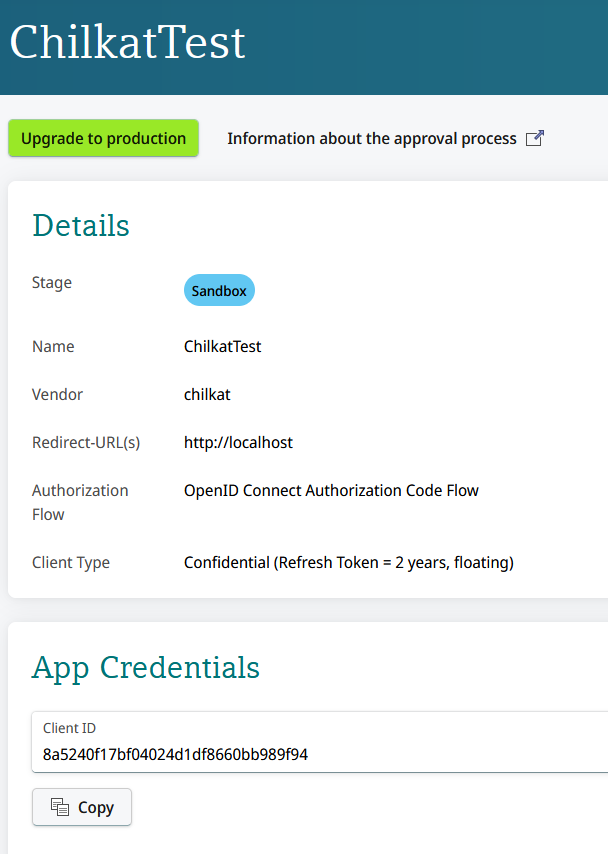|
|
(Swift) Datev OAuth2 Access Token
Demonstrates how to get a Datev OAuth2 access token from a desktop application or script.Note: This example requires Chilkat v10.1.3 or greater.
func chilkatTest() {
// To further clarify, see OAuth 2.0 Authorization Flow
let oauth2 = CkoOAuth2()!
// Your Datev app should use "http://localhost" (no trailing forward slash) for the redirect URL.
oauth2.listenPort = 3017
//  oauth2.authorizationEndpoint = "https://login.datev.de/openidsandbox/authorize"
oauth2.tokenEndpoint = "https://sandbox-api.datev.de/token"
// Replace this with your actual client ID.
oauth2.clientId = "DATEV_CLIENT_ID"
oauth2.clientSecret = "DATEV_CLIENT_SECRET"
oauth2.codeChallenge = true
oauth2.codeChallengeMethod = "S256"
oauth2.scope = "openid profile email datev:accounting:clients accounting:documents datev:accounting:extf-files-import"
// Begin the OAuth2 authorization code flow. This returns a URL that should be loaded in a browser.
var url: String? = oauth2.start()
if oauth2.lastMethodSuccess != true {
print("\(oauth2.lastErrorText!)")
return
}
// Launch the default browser on the system and navigate to the url.
// The LaunchBrowser method was added in Chilkat v10.1.2.
var success: Bool = oauth2.launchBrowser(url)
if success == false {
print("\(oauth2.lastErrorText!)")
return
}
// Wait for the interactive user to grant permission in the interactive browser session.
// We'll wait for a max of 90 seconds.
var numMsWaited: Int = 0
while (numMsWaited < 90000) && (oauth2.authFlowState.intValue < 3) {
oauth2.sleepMs(100)
numMsWaited = numMsWaited + 100
}
// If there was no response from the browser within 90 seconds, then
// the AuthFlowState will be equal to 1 or 2.
// 1: Waiting for Redirect. The OAuth2 background thread is waiting to receive the redirect HTTP request from the browser.
// 2: Waiting for Final Response. The OAuth2 background thread is waiting for the final access token response.
// In that case, cancel the background task started in the call to StartAuth.
if oauth2.authFlowState.intValue < 3 {
oauth2.cancel()
print("No response from the browser!")
return
}
// Check the AuthFlowState to see if authorization was granted, denied, or if some error occurred
// The possible AuthFlowState values are:
// 3: Completed with Success. The OAuth2 flow has completed, the background thread exited, and the successful JSON response is available in AccessTokenResponse property.
// 4: Completed with Access Denied. The OAuth2 flow has completed, the background thread exited, and the error JSON is available in AccessTokenResponse property.
// 5: Failed Prior to Completion. The OAuth2 flow failed to complete, the background thread exited, and the error information is available in the FailureInfo property.
if oauth2.authFlowState.intValue == 5 {
print("OAuth2 failed to complete.")
print("\(oauth2.failureInfo!)")
return
}
if oauth2.authFlowState.intValue == 4 {
print("OAuth2 authorization was denied.")
print("\(oauth2.accessTokenResponse!)")
return
}
if oauth2.authFlowState.intValue != 3 {
print("Unexpected AuthFlowState:\(oauth2.authFlowState.intValue)")
return
}
// Save the full JSON access token response to a file.
let sbJson = CkoStringBuilder()!
sbJson.append(oauth2.accessTokenResponse)
sbJson.writeFile("qa_data/tokens/datev.json", charset: "utf-8", emitBom: false)
// The saved JSON response looks like this:
// {
// "refresh_token": "ZDA5Y .... FFhTXc9",
// "refresh_token_expires_in": 39600,
// "id_token": "eyJ .... Q9w",
// "access_token": "MTM .... 1UDA9",
// "token_type": "bearer",
// "expires_in": 900
// }
print("OAuth2 authorization granted!")
print("Access Token = \(oauth2.accessToken!)")
}
oauth2.authorizationEndpoint = "https://login.datev.de/openidsandbox/authorize"
oauth2.tokenEndpoint = "https://sandbox-api.datev.de/token"
// Replace this with your actual client ID.
oauth2.clientId = "DATEV_CLIENT_ID"
oauth2.clientSecret = "DATEV_CLIENT_SECRET"
oauth2.codeChallenge = true
oauth2.codeChallengeMethod = "S256"
oauth2.scope = "openid profile email datev:accounting:clients accounting:documents datev:accounting:extf-files-import"
// Begin the OAuth2 authorization code flow. This returns a URL that should be loaded in a browser.
var url: String? = oauth2.start()
if oauth2.lastMethodSuccess != true {
print("\(oauth2.lastErrorText!)")
return
}
// Launch the default browser on the system and navigate to the url.
// The LaunchBrowser method was added in Chilkat v10.1.2.
var success: Bool = oauth2.launchBrowser(url)
if success == false {
print("\(oauth2.lastErrorText!)")
return
}
// Wait for the interactive user to grant permission in the interactive browser session.
// We'll wait for a max of 90 seconds.
var numMsWaited: Int = 0
while (numMsWaited < 90000) && (oauth2.authFlowState.intValue < 3) {
oauth2.sleepMs(100)
numMsWaited = numMsWaited + 100
}
// If there was no response from the browser within 90 seconds, then
// the AuthFlowState will be equal to 1 or 2.
// 1: Waiting for Redirect. The OAuth2 background thread is waiting to receive the redirect HTTP request from the browser.
// 2: Waiting for Final Response. The OAuth2 background thread is waiting for the final access token response.
// In that case, cancel the background task started in the call to StartAuth.
if oauth2.authFlowState.intValue < 3 {
oauth2.cancel()
print("No response from the browser!")
return
}
// Check the AuthFlowState to see if authorization was granted, denied, or if some error occurred
// The possible AuthFlowState values are:
// 3: Completed with Success. The OAuth2 flow has completed, the background thread exited, and the successful JSON response is available in AccessTokenResponse property.
// 4: Completed with Access Denied. The OAuth2 flow has completed, the background thread exited, and the error JSON is available in AccessTokenResponse property.
// 5: Failed Prior to Completion. The OAuth2 flow failed to complete, the background thread exited, and the error information is available in the FailureInfo property.
if oauth2.authFlowState.intValue == 5 {
print("OAuth2 failed to complete.")
print("\(oauth2.failureInfo!)")
return
}
if oauth2.authFlowState.intValue == 4 {
print("OAuth2 authorization was denied.")
print("\(oauth2.accessTokenResponse!)")
return
}
if oauth2.authFlowState.intValue != 3 {
print("Unexpected AuthFlowState:\(oauth2.authFlowState.intValue)")
return
}
// Save the full JSON access token response to a file.
let sbJson = CkoStringBuilder()!
sbJson.append(oauth2.accessTokenResponse)
sbJson.writeFile("qa_data/tokens/datev.json", charset: "utf-8", emitBom: false)
// The saved JSON response looks like this:
// {
// "refresh_token": "ZDA5Y .... FFhTXc9",
// "refresh_token_expires_in": 39600,
// "id_token": "eyJ .... Q9w",
// "access_token": "MTM .... 1UDA9",
// "token_type": "bearer",
// "expires_in": 900
// }
print("OAuth2 authorization granted!")
print("Access Token = \(oauth2.accessToken!)")
}
|

